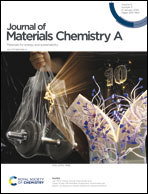Unveiling the multifunctional regulation effect of a glutamine additive for highly reversible Zn metal anodes†
Abstract
Uncontrollable side reactions and dendrites severely undermine the stability and reversibility of Zn anodes and remain significant challenges for aqueous zinc-ion batteries (AZIBs). Herein, it is demonstrated that glutamine (Gln) is a multifunctional electrolyte additive to enable highly stable and reversible Zn anodes. Theoretical and experimental results reveal that Gln has three functions: preferentially absorbing on the Zn anode and constructing a water-poor interface, enhancing the steric effect, and optimizing the solvation structures of Zn2+. Consequently, Zn//Zn batteries exhibited an impressive cycling durability and high cumulative capacity at 3 mA cm−2. Furthermore, Zn//Cu batteries also demonstrated a remarkably reversible stripping/deposition process accompanied by a notably high average coulombic efficiency of 99.6%. In addition, the fabricated Zn//NH4V4O10 batteries with Gln also yielded impressive cycle performances and capacity retention. Gln exhibits promising attributes as a cost-effective and versatile electrolyte additive to facilitate the stability and reversibility of AZIBs.



 Please wait while we load your content...
Please wait while we load your content...